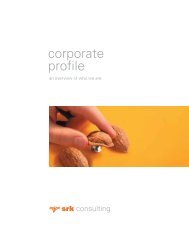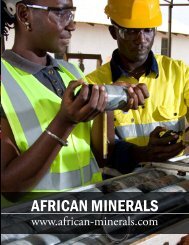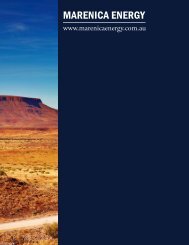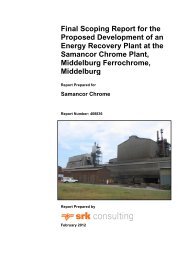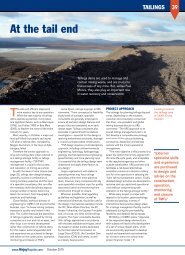Draft Status Quo Report for the Pixley Ka Seme ... - SRK Consulting
Draft Status Quo Report for the Pixley Ka Seme ... - SRK Consulting
Draft Status Quo Report for the Pixley Ka Seme ... - SRK Consulting
You also want an ePaper? Increase the reach of your titles
YUMPU automatically turns print PDFs into web optimized ePapers that Google loves.
<strong>SRK</strong> <strong>Consulting</strong> in association with BKS<br />
<strong>Pixley</strong> <strong>Ka</strong> <strong>Seme</strong> Local Municipality EMF – <strong>Draft</strong> <strong>Status</strong> <strong>Quo</strong> <strong>Report</strong> Page 53<br />
Asset Opportunity Constraint / Threat<br />
Africa and internationally<br />
Water resources include:<br />
• Relatively high rainfall in<br />
<strong>the</strong> mountainous area<br />
providing inter alia,<br />
<strong>for</strong>estry and agricultural<br />
potential<br />
• Groundwater and springs<br />
• Dams<br />
• Natural resources include<br />
that associated with <strong>the</strong><br />
wetlands and pans.<br />
Wetlands in <strong>the</strong> PKSLM<br />
per<strong>for</strong>m essential<br />
ecosystem functions<br />
including flood<br />
attenuation, ‘polishing’ of<br />
water (cleaning) and<br />
habitat <strong>for</strong> aquatic<br />
ecosystems. They also<br />
act as ‘sponges’, and play<br />
a key role in <strong>the</strong><br />
sustaining of year-round<br />
water flow (Palmer, 2010)<br />
Mining (particularly coal) is an<br />
economically and strategically<br />
important activity in <strong>the</strong> GSDM<br />
with high potential <strong>for</strong><br />
expansion in <strong>the</strong> PKSLM<br />
Productive agricultural land<br />
(rough grazing and cultivation)<br />
and <strong>for</strong>estry are economically<br />
important in <strong>the</strong> PKSLM<br />
High tourism/ecotourism<br />
potential (including pans a<br />
wetlands and o<strong>the</strong>r ecological<br />
assets, geological features,<br />
scenic beauty, heritage and<br />
agriculture<br />
management of <strong>the</strong> PKSLM water resource<br />
are presented by:<br />
• Prevention of stormwater ingress into<br />
<strong>the</strong> mines and o<strong>the</strong>r routes into <strong>the</strong><br />
mining void, as well as fixing and<br />
upgrade of leaking water supply<br />
pipelines could reduce <strong>the</strong> AMD<br />
• A comprehensive strategy to deal with<br />
water quantity and quality issues facing<br />
<strong>the</strong> PKSLM and catchments beyond<br />
due to mine closures needs to be<br />
implemented<br />
• Streng<strong>the</strong>ning of sustainability<br />
underpinning <strong>the</strong> IDPs when <strong>the</strong>se<br />
come up <strong>for</strong> periodic review<br />
• Improved inter-departmental<br />
coordination <strong>for</strong> EIA and SEMP<br />
authorisations and water use licences.<br />
The opportunity is <strong>the</strong>re <strong>for</strong> proactive<br />
protection of <strong>the</strong> valuable water resources<br />
of <strong>the</strong> PKSLM, such as through <strong>the</strong> water<br />
sensitivity map.<br />
Agricultural production facilities and water<br />
treatment works can consider <strong>the</strong><br />
construction of artificial wetlands as one<br />
part of <strong>the</strong>ir strategy to treat effluent be<strong>for</strong>e<br />
it reaches surface and ground water<br />
(although this cannot be <strong>the</strong> primary<br />
treatment means).<br />
Appropriate management of water quality<br />
and quantity impacts from agriculture and<br />
af<strong>for</strong>estation in particular away from <strong>the</strong><br />
wetlands.<br />
limiting factor to development due to high<br />
demands <strong>for</strong> water use. Alien vegetation<br />
infestation fur<strong>the</strong>r poses a risk to water<br />
availability.<br />
Over allocation of water resources poses a<br />
risk to <strong>the</strong> aquatic ecosystems which play a<br />
key role in <strong>the</strong> maintenance of water quality<br />
and quantity.<br />
Problems associated with af<strong>for</strong>estation and<br />
agriculture include:<br />
• Agricultural production and<br />
af<strong>for</strong>estation contribute nutrient loads<br />
and o<strong>the</strong>r contaminants to surface and<br />
groundwater<br />
• Stream flow reduction (particularly by<br />
af<strong>for</strong>estation) poses a risk to water<br />
availability <strong>for</strong> ecological systems and<br />
o<strong>the</strong>r water uses.<br />
Problems associated with coal-mining<br />
include:<br />
• A large proportion of <strong>the</strong> collieries will<br />
eventually decant water onto <strong>the</strong><br />
surface following closure. Pollution<br />
from AMD poses a threat to <strong>the</strong><br />
surface-and groundwater quality of <strong>the</strong><br />
PKSLM and beyond, <strong>the</strong> fitness- <strong>for</strong>use<br />
of <strong>the</strong> water and ecosystem<br />
functioning. Prevention of decant of<br />
AMD.<br />
• A large contribution to AMD originates<br />
from stormwater ingress, also possibly<br />
contributed to by leaking water mains.<br />
• Difficulty of removal of pollution<br />
associated with AMD, with remediation<br />
technology such as reverse osmosis<br />
being very costly.<br />
• There are health risks to public reliant<br />
on AMD contaminated surface- and<br />
groundwater.<br />
Not all of <strong>the</strong> operational mines have<br />
approved Environmental Management<br />
Programmes.<br />
Degradation of <strong>the</strong> PKSLM could place <strong>the</strong><br />
RAMSAR site at risk.<br />
There appears to be a lack of a clear<br />
strategy on how to deal with <strong>the</strong> mine<br />
decant between government departments,<br />
as well as o<strong>the</strong>r stakeholders.<br />
Shallow-lying coal deposits may be mined<br />
by small-scale miners. Problems associated<br />
with small-scale mining in sou<strong>the</strong>rn Africa<br />
include:<br />
• Higher TDS levels in <strong>the</strong> rivers<br />
• Increased erosion and degradation of<br />
<strong>the</strong> rivers<br />
• Water quality impacts from AMD.<br />
Wetland system in <strong>the</strong><br />
Wakkerstroom area and<br />
surrounds<br />
Avoidance of development in <strong>the</strong> wetlands<br />
and riverine systems.<br />
The development of tourism needs to be<br />
done to maximise opportunities <strong>for</strong> local<br />
people without significantly impacting <strong>the</strong><br />
Wetlands and riverine systems beyond<br />
pose a physical limitation on <strong>the</strong><br />
development potential of <strong>the</strong> area:<br />
• Development near <strong>the</strong> rivers should be<br />
KILI/BEAT G:\404946_PIXLEY EMF\7REPORTS\<strong>Status</strong> <strong>Quo</strong> report\<strong>Draft</strong> report\<strong>Draft</strong> status quo report, July 2010.docx July 2010



